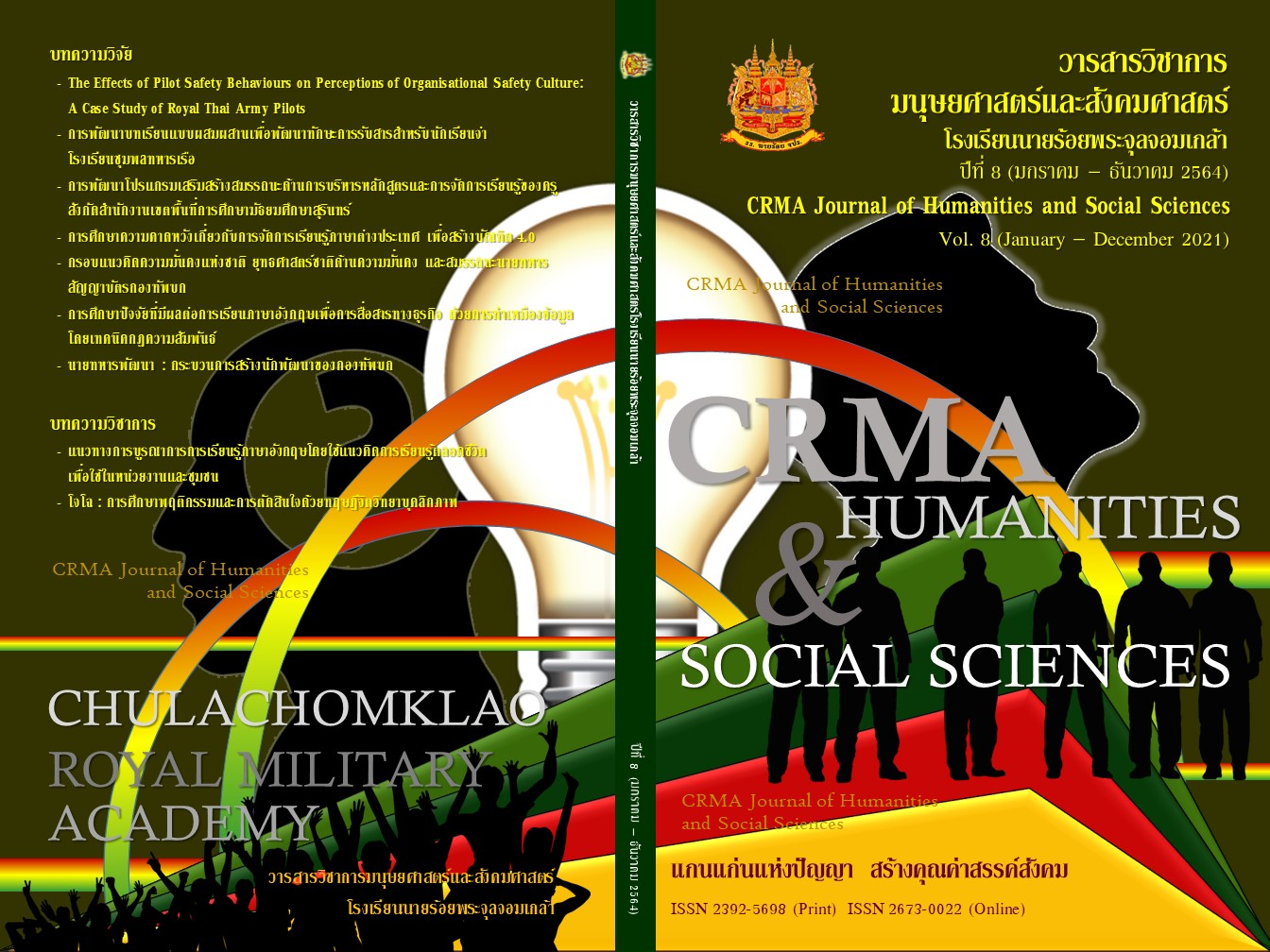CONCEPTUAL FRAMEWORK OF NATIONAL SECURITY, THE NATIONAL SECURITY STRATEGY, AND ROYAL THAI ARMY COMMISSIONED OFFICERS’ COMPETENCY
Keywords:
National Security, The National Security Strategy, Royal Thai Army, Commissioned officers’ competencyAbstract
The purpose of this research was to study the conceptual framework of national security, the national security strategy, and Royal Thai Army commissioned officer’s competency. The research was a qualitative research, which utilized conceptual framework evaluation and in-depth interviews. There were 10 research informants including 5 military experts, 2 Royal Thai Army commissioned officers who are involved in research regarding commissioned officers’ competency or national security, and 3 Royal Thai Army commissioned officers who graduated from Chulachomklao Royal Military Academy or from abroad. Research instruments consisted of a conceptual framework evaluation form and Semi-structured interview form. Content analysis from the evaluation and interview was used. The research findings indicated that: 1) There was a change in the national security context that occurred at the global, regional, and national levels, where each level was interrelated. The threat model composed of traditional and non-traditional threats. The actor could be both a state and non-state. Threat patterns changed with technological advances. Finally, the change in security threat models affected military operations; 2) According to the National Security Strategy, the Royal Thai Army’s missions could be classified into 3 groups: (1) National defense, (2) maintaining order and domestic security, and (3) Non-military operations; and 3) The Royal Thai Army commissioned officers had 5 competencies: (1) Leadership, (2) Operational skills, (3) General knowledge, (4) Readiness for change, and (5) Language skills.
References
ดุลยวัฒน์ เชาวน์ดี. (2559). กองทัพเรือในทศวรรษหน้า. วารสารนาวิกศาสตร์, 99(2), 36-47.
ธนะศักดิ์ ปฏิมาประกร. (2557). การบริหารจัดการความมั่นคงชายแดนของกองทัพไทยภายใต้กระบวนทัศน์ความมั่นคงใหม่ ในบริบทประชาคมการเมืองและความมั่นคงอาเซียน (วิทยานิพนธ์ปรัชญาดุษฎีบัณฑิต สาขารัฐประศาสนศาสตร์). มหาวิทยาลัยบูรพา.
พร ภิเศก. (2558). กองทัพบกกับภัยคุกคามความมั่นคงรูปแบบต่าง ๆ. กรุงเทพฯ: ศูนย์พัฒนาหลักนิยมและยุทธศาสตร์ กรมยุทธศึกษาทหารบก.
ภคภณ สนิมสม และณัฐพล จารัตน์. (2558). คุณลักษณะผู้นำทางทหารที่พึงประสงค์ของกองทัพไทย. วารสารนักบริหาร, 35(1), 75-86.
ราชกิจจานุเบกษา. (2560). รัฐธรรมนูญแห่งราชอาณาจักรไทย พุทธศักราช 2560.
ราชกิจจานุเบกษา. (2561). ยุทธศาสตร์ชาติ พ.ศ.2561-2580.
โรงเรียนนายร้อยพระจุลจอมเกล้า. (2560). แผนพัฒนาโรงเรียนนายร้อยพระจุลจอมเกล้า พ.ศ.2560-2564.
วิทยาลัยป้องกันราชอาณาจักร. (2553). เอกสาร วปอ.หมายเลข 008 คู่มือเรื่องความมั่นคงแห่งชาติ. กรุงเทพฯ: วิทยาลัย ป้องกันราชอาณาจักร.
วิทยาลัยป้องกันราชอาณาจักร. (2554). เอกสาร วปอ. หมายเลข 013 คู่มือด้านการทหาร. กรุงเทพฯ: วิทยาลัยป้องกันราชอาณาจักร.
วิทิต ทวีสุข. (2557). พัฒนาการทางทหารในภูมิภาคเอเชียตะวันออกเฉียงใต้. กรุงเทพฯ: โครงการความมั่นคงศึกษา จุฬาลงกรณ์มหาวิทยาลัย, 39-40.
ศูนย์ศึกษายุทธศาสตร์ สถาบันวิชาการป้องกันประเทศ. (2554). การพัฒนาหลักการจัดการความมั่นคงไม่ตามแบบ (พิมพ์ครั้งที่ 1).
สำนักงานคณะกรรมการการอุดมศึกษา. (2558). ประกาศคณะกรรมการการอุดมศึกษา เรื่อง แนวทางการปฏิบัติตามกรอบมาตรฐานคุณวุฒิระดับอุดมศึกษาแห่งชาติ (ฉบับที่ 3) พ.ศ. 2558.
สุรชาติ บำรุงสุข. (2558). การก่อการร้ายใหม่ : ยุคหลังปารีส. [จุลสาร]. กรุงเทพฯ: จุฬาลงกรณ์มหาวิทยาลัย, โครงการความมั่นคงศึกษา, 7.
สภาความมั่นคงแห่งชาติ สำนักนายกรัฐมนตรี. (2558). นโยบายความมั่นคงแห่งชาติ พ.ศ.2558-2564 (พิมพ์ครั้งที่ 1). สำนักพิมพ์คณะรัฐมนตรีและราชกิจจานุเบกษา, 3.
Abbott, C., Rogers, P. & Sloboda, J. (2006). Global Responses to Global Threats: Sustainable Security for the 21st century: Oxford Research Group.
Army National Guard Office. (2012). The ARMY National Guard Leader Development Strategy, 12.
Civils, T. H., Jr. (2016). An assessment of the Command and General Staff Officer Core Course effectiveness in developing student critical thinking. (Doctoral dissertation). Kansas State University, USA, 3.
Department of the Army. (2015). FM 6-22 Leader Development. Washington DC: Department of the Army.
Horey, J., Harvey, J., Curtin, P., Keller-Glaze, H., Morath. R., & Fallesen, J. (2007). A Criterion-Related Validation Study of the Army Core Leader Competency Model: United States Army Research Institute for the Behavioral and Social Sciences, 5-6.
Moore, C. S., Sortor, R. E., Leonard, H. A., Polich, M. J., & Peterson, J. (2006). Something Old, Something New Army Leader Development in a Dynamic Environment: Rand publishing, 15.
Mesa, W. S. (2015). Downsizing the United Air Force Security Forces: Phenomenological Investigation. (Doctoral dissertation). Walden University, USA.
Miller, M. (2015). Hybrid warfare: Preparing for future conflict (Research Report). Air War College, USA.
Office of the Dean. (2006). Educating future officers for a changing world. Retrieved 23 March 2020, from United states Military Academy Westpoint. http://www.usma.edu/strategic/SiteAssets/SitePages/Home/EFAOCW.pdf
Woodring, W. O. (2007). The role of the army force generation model in preparing the national guard and reserve for future operations. (Master thesis). The United States Army Command and General Staff College, USA.
Downloads
Published
How to Cite
Issue
Section
License
The content and information in this journal shall be considered as the individual opinions of the authors. In all cases, the editorial board may not necessarily agree with these opinions or be responsible for them.
The articles and information that are published in the journal are considered to be the copyright of the journal. Any party who wishes to re-publish the journal’s articles must seek permission from the journal’s editor. Articles that receive the agreement for publications must not appear in any other publications prior to their appearance in this journal. The editorial board will send one copy of the journal to each author whose submission was accepted and published.







